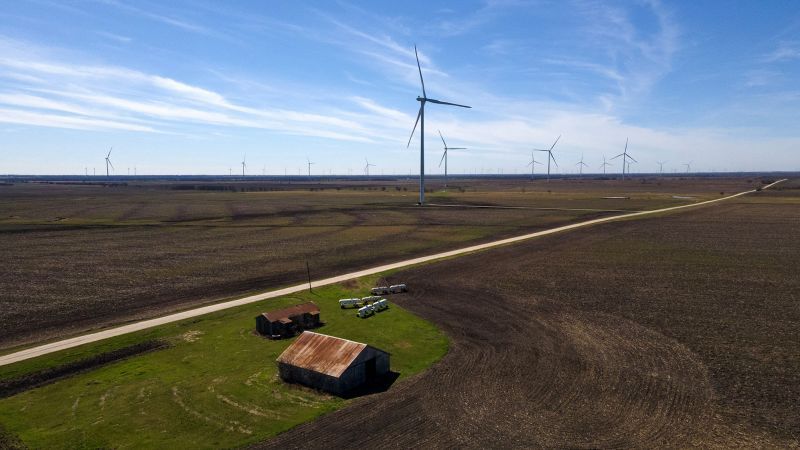Wind and solar are propping up the Texas power grid amid a brutally long heat wave
CNN —
As Texas bakes under a sweltering heat dome this summer and people crank their air conditioners, the state’s energy demand has smashed records. But the power has stayed on and prices haven’t spiked tremendously.
Thank wind and solar, energy experts say.
“Renewables have been performing very well this summer, which is great,” Michael Webber, an energy expert and professor at the University of Texas at Austin, told CNN. “It’s operating so well at peak times.”
As temperatures soared into the triple-digits on Wednesday, renewable energy was providing 30 to 40% of the power the state needed, according to analysis of state data from Texas energy expert Doug Lewin.
And as the state struggled through an early heatwave in June, non-fossil fuel power including renewables and nuclear made up 55% of total generation on June 28 and 29 and close to 50% of the power needed during the evening peak, according to statistics from the federal Energy Information Administration.
Wind and solar have been working well in tandem, Webber said. Solar has been generating a lot of energy during the day when the sun is beating down, and wind has been performing well during the evening hours.
Renewables have been a lifeline for the Texas grid as some older thermal plants — which run on coal, natural gas, and nuclear — have gone offline throughout the summer, according to Texas energy expert Doug Lewin, founder of consulting firm Stoic Energy.
“The thermal plants have bounced up and down,” Lewin told CNN, saying thermal plant outages during heatwaves have been high by Texas grid manager ERCOT’s own standards. “You have the thermal outages being consistent in that high level and renewables doing quite well throughout the summer.”
The Texas solar boom
An ENGIE employee walks past solar panels at the ENGIE Sun Valley Solar project in Hill County, Texas. Mark Felix/AFP/Getty Images
Despite some anti-renewable bills introduced in the Texas legislature this year, the state has been adding renewables — particularly solar — at an incredible clip.
The US Energy Information Administration estimates the Lone Star state will install more utility-scale solar capacity in 2023 than any other state, around 7.7 gigawatts this year alone. And the federal energy administration expects the state to bring another 24.8 gigawatts of additional solar capacity online by the end of 2025. Together, that’s enough to power over 10 million homes.
The state is also rapidly installing battery storage, to store wind and solar energy when the sun isn’t shining and wind isn’t blowing.
Solar is the new “darling” of Texas energy, Webber said, in large part because it’s cheap and far easier to install than constructing a new natural gas or nuclear plant.
“It’s the only thing you can build quickly enough,” he told CNN. “There’s no way last summer to this one we could have built a gas plant, a nuclear plant. It doesn’t need water cooling; it doesn’t need an air quality permit.”
Solar buildout is coming on the heels of a previous wind boom in Texas. The state has installed more wind capacity since 2019, but the wind buildout is slowing and solar is likely to soon eclipse it. However, there are early plans for offshore wind farms in the Gulf of Mexico, which could add more renewables to the state’s grid.
Natural gas remains an important part of electricity generation on the state’s grid, as well, and low natural gas prices combined with strong renewable performance has helped keep prices from spiking this summer, Webber said.
ERCOT officials expressed concerns about relying too much on renewables earlier this year, saying more natural gas plants should be built. But Lewin said that’s a misguided strategy, and this summer has shown renewables are a very important part of the grid’s resiliency during hot weather.
“I think what they’re leaving out is the intermittency of the thermal plants, they continue to neglect that,” Lewin said. “To represent to the public that if we just had more of these fossil fuel plants, everything would be fine, is ludicrous. That’s not to say renewables are a panacea, but the point is thermal plants are also not a panacea.”
Source: CNN


